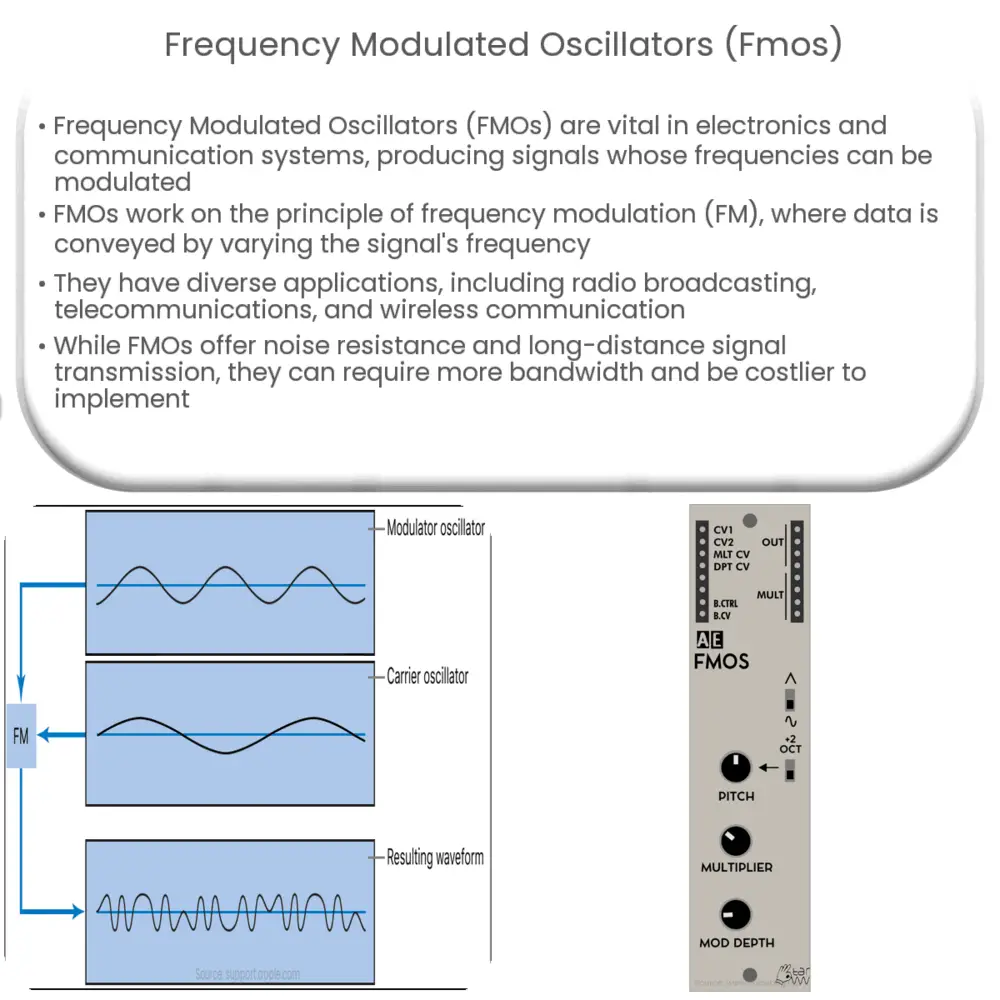Explore the mechanics, applications, benefits, and limitations of Frequency Modulated Oscillators (FMOs) in modern communication systems.

Understanding Frequency Modulated Oscillators (FMOs)
Frequency Modulated Oscillators, or FMOs, represent a crucial component in the realm of electronics and communication systems. They are designed to generate waveforms or signals, which can vary based on a specific characteristic called the frequency. In other words, FMOs are responsible for producing a signal with a frequency that can be changed or modulated over time.
The Mechanics of FMOs
The central operating principle of FMOs revolves around the concept of frequency modulation (FM). FM is a method of impressing data onto an alternating current (AC) signal by varying the frequency of the waveform. The data can be voice, music, digital information, or any other type of signal. The oscillator, as its name suggests, oscillates or vibrates, producing a waveform at a particular frequency. When this frequency is modulated or varied, it carries the data from the source to the receiver.
- Carrier Wave: This is the original frequency of the signal that the oscillator generates. The oscillator keeps producing this wave until some external data is used to modulate it.
- Modulating Wave: This is the data that you want to transmit using the carrier wave. This data causes the carrier wave to change its frequency, hence the term ‘frequency modulation’.
- Modulated Wave: This is the final output from the FMO. It is the carrier wave, but its frequency has been altered according to the modulating wave.
Applications of FMOs
FMOs have a broad spectrum of applications due to their inherent characteristic of frequency modulation. From radio broadcasting to wireless communication, they have a significant role in facilitating data transmission. Let’s explore some of the primary areas where FMOs are widely used:
- Radio Broadcasting: FM radio broadcasting uses Frequency Modulated Oscillators to transmit audio signals. Here, the audio signal serves as the modulating wave, altering the frequency of the carrier wave to transmit radio signals.
- Telecommunications: In telecommunications, FMOs are essential in facilitating the transmission of data over long distances without significant signal loss. The modulating wave in this case could be voice or data signals, which are transmitted over carrier waves.
- Wireless Communication: Wireless communication technologies such as Bluetooth and Wi-Fi also employ FMOs. They modulate digital data onto carrier frequencies for transmission between devices.
- Astronomy: In radio astronomy, FMOs are used in the reception and analysis of radio signals from celestial objects.
- Sound Synthesis: In music technology, FMOs are used in synthesizers to create complex waveforms and sounds.
Advantages and Disadvantages of FMOs
Just like any technology, FMOs come with their own sets of advantages and disadvantages. On the upside, they offer excellent noise resistance and superior sound quality in the case of FM broadcasting. This is due to the fact that frequency modulated signals are less susceptible to signal interference. Additionally, FMOs can transmit signals over long distances with minimal loss.
However, FMOs do have a few drawbacks. Frequency modulation requires a wider bandwidth compared to amplitude modulation. As a result, it may not be as efficient in terms of spectrum usage. Furthermore, FMOs and their related systems can be complex and costly to implement.
Conclusion
In conclusion, Frequency Modulated Oscillators (FMOs) play a pivotal role in the landscape of modern communication systems. Their ability to generate and modulate signals paves the way for various applications, from radio broadcasting to wireless communication technologies. Although they come with certain limitations, the versatility and robustness of FMOs make them an indispensable component in electronics and communication engineering. As technology continues to evolve, it is likely that the functionality and efficiency of FMOs will continue to improve, further broadening their scope and potential applications in the future.



